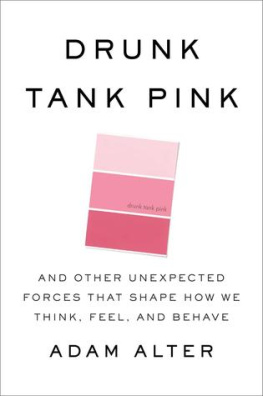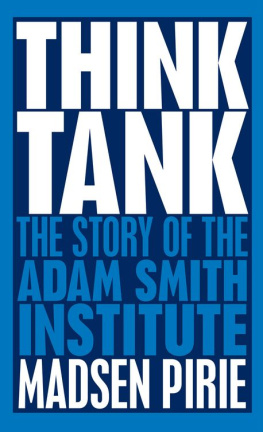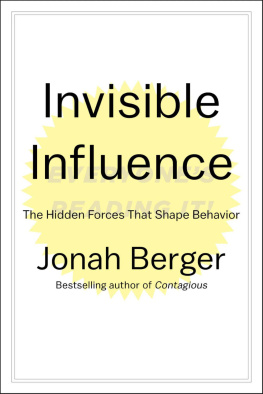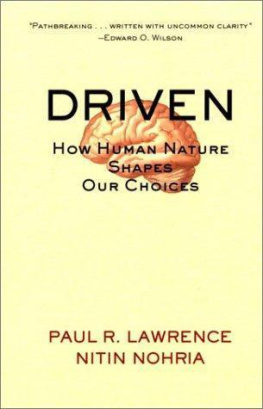

THE PENGUIN PRESS
Published by the Penguin Group
Penguin Group (USA) Inc., 375 Hudson Street,
New York, New York 10014, USA

USA Canada UK Ireland Australia New Zealand India South Africa China
Penguin Books Ltd, Registered Offices: 80 Strand, London WC2R 0RL, England
For more information about the Penguin Group visit penguin.com
Copyright Adam Alter, 2013
All rights reserved. No part of this book may be reproduced, scanned, or distributed in any printed or electronic form without permission. Please do not participate in or encourage piracy of copyrighted materials in violation of the authors rights. Purchase only authorized editions.
The credits for the illustrations on pages 31, 110, 114, and 130 respectively appear in the notes section.
Library of Congress Cataloging-in-Publication Data
Alter, Adam L., 1980-
Drunk tank pink : and other unexpected forces that shape how we think, feel, and behave / Adam Alter.
pages cm
Includes bibliographical references.
ISBN 978-1-101-60578-3
1. Psychology, Applied. 2. Environmental psychology. I. Title.
BF636.A48 2012
155.9--dc23
2012046810

For Mum, Dad, Dean, and Sara
CONTENTS
PROLOGUE
T he academic journal Orthomolecular Psychiatry began its final issue of 1979 with a classic paper that kindled the imaginations of prison wardens, football coaches, and exasperated parents. The papers author, Professor Alexander Schauss, described a simple experiment featuring 153 healthy young men, a researcher, two large pieces of colored cardboard, and a well-lit lab room. One by one the men filed into the room to participate in an unusual test of strength. The experiment began when the men stared at one of the pieces of cardboard. For half the men the cardboard was deep blue in color, while for the remaining half it was bright pink. After a full minute passed, the researcher asked the men to raise their arms in front of their bodies, while he applied just enough downward pressure to force their arms back down to their sides. While the men recovered their strength, the researcher jotted a few brief notes before repeating the experiment, first asking the men to stare at the other piece of cardboard and then repeating the strength test.
The results were strikingly consistent. All but two of the men were dramatically weaker after staring at the pink cardboard, barely resisting the researchers application of downward force. In contrast, the blue cardboard left their strength intact, regardless of whether it came before the first or second strength test. The color pink appeared to leave the men temporarily depleted.
To prove the effect wasnt a fluke, Schauss conducted a second experiment. This time he used a more accurate measure of strength, asking the thirty-eight male participants to squeeze a measurement device known as a dynamometer. Without fail, one after another, all thirty-eight men squeezed the device more weakly after staring at the pink cardboard.
Schauss began describing the miraculous tranquilizing power of bright pink in public lectures across the United States. At one appearance, filmed for TV, a muscle-bound Mr. California performed several effortless biceps curls but struggled to perform a single curl after staring at the pink cardboard. Given the colors power, Schauss suggested that corrections officers should consider detaining rowdy prisoners in pink cells, and two commanding officers at the U.S. Naval Correctional Center in Seattle, Washington, repainted one of their holding cells bright pink. For seven months, Chief Warrant Officer Gene Baker and facility commander Captain Ron Miller watched as newly arrived inmates entered the pink cell angry and agitated but emerged calmer fifteen minutes later. New prisoners are traditionally aggressive, but the officers reported not a single violent incident during the seven-month trial period.
Admirers honored the enterprising officers by calling the color Baker-Miller Pink, and other facilities around the country painted special holding cells the same bubblegum hue. At a detention center in San Jose, California, some of the younger inmates were so weakened by the pink cell that their exposure had to be limited to just a few minutes a day. When smaller county jails began tossing violent drunks into pink holding cells, the color was unofficially christened Drunk Tank Pink.
In the early 1980s, Drunk Tank Pink became a minor popular culture sensation. Schauss discovered that frazzled psychiatrists, dentists, doctors, teachers, and parents were painting their walls bright pink. Public housing estates painted their interiors pink and reported a sharp decline in violent behavior, and bus companies quashed vandalism by installing bright pink seats. When United Way charity workers wore pink uniforms, donors reportedly gave up to two or three times as much as they usually did. Football coaches at Colorado State and the University of Iowa painted their visitors locker rooms pink in an attempt to pacify their opponents, until local athletics conferences decreed that the home and visitors locker rooms had to be identical. Tex Schramm, longtime coach of the Dallas Cowboys football team, called Schauss and asked whether his team should adopt the same strategy. Underdogs in the boxing ring began wearing pink trunks and sometimes even beat their heavily favored opponents.
Drunk Tank Pink emerged as the unlikely solution to a host of difficult puzzles, from aggression and hyperactivity to anxiety and competitive strategy. The color attracted a frenzy of academic interest late into the 1990s, and while some researchers found weaker evidence for the original effect, scattered demonstrations persisted. Schauss still calls Drunk Tank Pink a non-drug anesthetic, and he continues to field dozens of inquiries each year, more than three decades since Drunk Tank Pinks dramatic rise.
This book is an attempt to uncover the role of Drunk Tank Pink and dozens of other hidden forces as they shape how we think, feel, and behave. Some, like Drunk Tank Pink, emerge from nowhere to become pop culture legends. Others, like sunshine and beautiful women, have long occupied a prominent place in folk wisdom, though folk wisdom often falls short when it tries to capture the complexities of human behavior. And other forces still, like the names we give children and new business ventures, hide in plain sight, guiding our thoughts as we go about the business of everyday life unaware of their influence. Understanding these forces is more than a matter of idle curiosity, as some can be harnessed for the good while others are mitigated to prevent the bad. Some of them push us toward smarter decisions and happier outcomes, and others undermine our persistent quest for health and well-being. These forces (or cues , as psychologists call them) take many forms, arising from three different worlds: the mental world made up of small cues that burrow their way into our heads; the social world that connects us; and the wider physical world that surrounds us. Each of us is an ongoing product of the world within us, the world between us, and the world around usand their hidden capacity to shape our every thought, feeling, and behavior.
Next page















